ARCHITECTURAL ELEMENTS OF THE TOMB OF ANTONIO DE GRASSI AT CAPODISTRIA
This presentation is based on the following paper written by LUCIO NALESINI:
Grassi Brothers & Co. L'Architetto Capodistriano Gioachino Grassi e Fratelli nella Bangkok di fine secolo XIX; Annales, Series Historia et Sociologia, 10, 2000, 1; Annales University Press; Science and Research Centre of the University of Primorska, Koper, Slovenia.
The descriptions of the elements of the tomb that are provided below have been taken directly (cut and paste), either whole or in part, from the article cited above. I am responsible for any repetitive and confusing text. The two drawings are from the article; the photos in Bangkok I copied from the Internet; the photos of Antonio are from my collection. [My wording is bracketed.] The monument photos I took in May 2012 and September 2014.
<<<<<< >>>>>>
The monument is the sole example of a purely Thai monument built in Europe, and one executed carefully and lovingly in every detail. Whoever has seen the beautiful prangs of Wat Phra Keo, will certainly notice the perfect correspondence with the prangs of the Antonio De Grassi’s tomb. Anyone who has seen Wat Arun, and especially at dawn, can draw a parallel with the arrangement of the prangs of the Capodistria tomb. If anyone has seen the terrifying giant Yaksha with the gnashing teeth defending the gates of Wat Arun, will recognise them in the sculpture of one of the gables. Who is familiar with the Buddha statues that can be seen in plenty around Bangkok and their gestures will soon realise the position of Buddha as portrayed on another gable of the tomb.
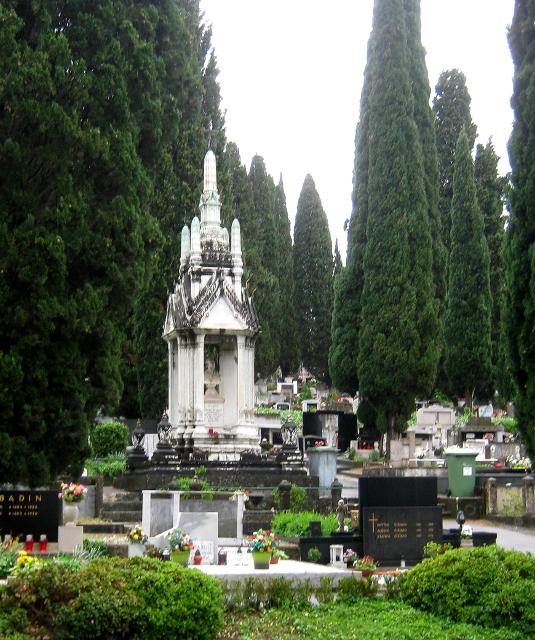
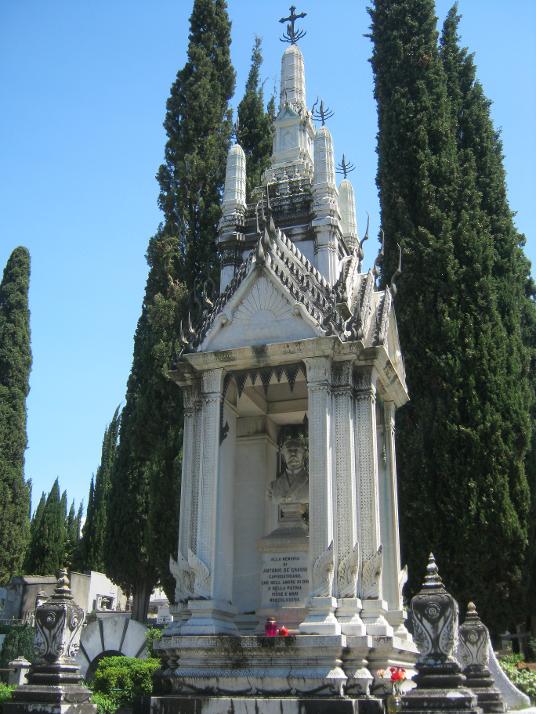
The funerary monument of Antonio De Grassi is made by a basement enclosed with a fence. Inside the fence there is a trap door giving access to the crypt where the deceased lies.
At the [monument’s] corners there stand four little stones.
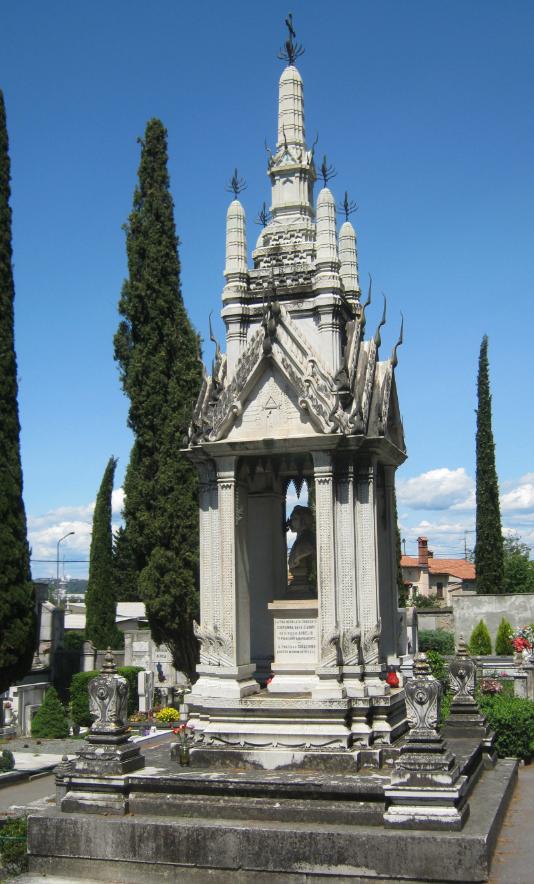
[Four corner stones - Bai Sema]
They were not placed there at random, nor is their shape casual, because it corresponds perfectly to most classic bai sem. What is a bai sema? It is a little stone usually placed at the four corners and at the mid-side of the sacred area where the Bot or Ubosot (the most sacred building of the Thai temple) stands.
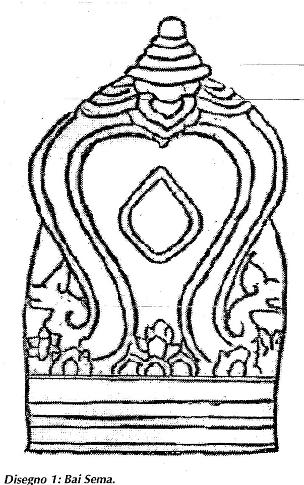
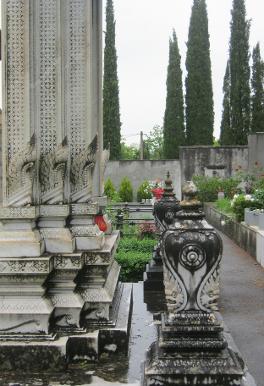
[Bai Sema]
Four triple pillars stand on [the monument's] corners, while the statue of the deceased stands in the centre. The base of each little pillar is decorated with a traditional Thai motive, that is the Nak canson, representing the bow of the Naga. Their shape undoubtedly comes from the leaves wrapping the node of the bamboo cane.

[Bai Sema, triple pillars and Nak canson.]
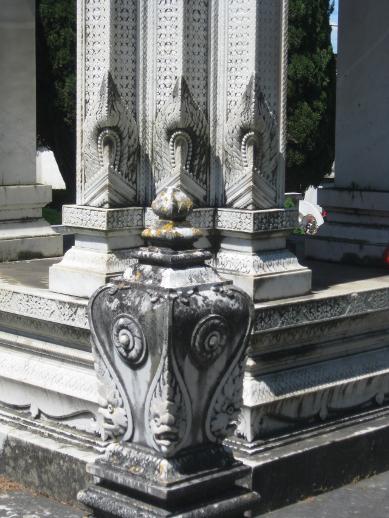
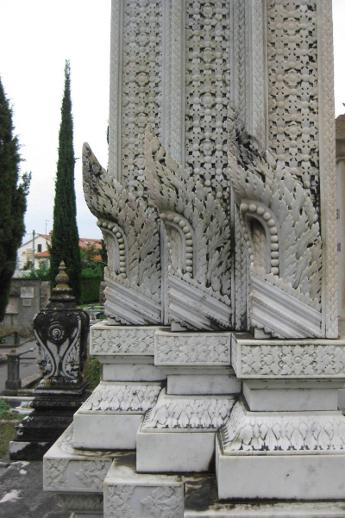
The decorations at the base of these pillars represent the bow, the weapon of the Nagas, while the pillars are covered with a scale-motive, because naga is a Sanskrit word meaning “snake”.
In the centre of the pedestal rises the statue of Antonio covered on the four sides by four tombstones, on which one may read:
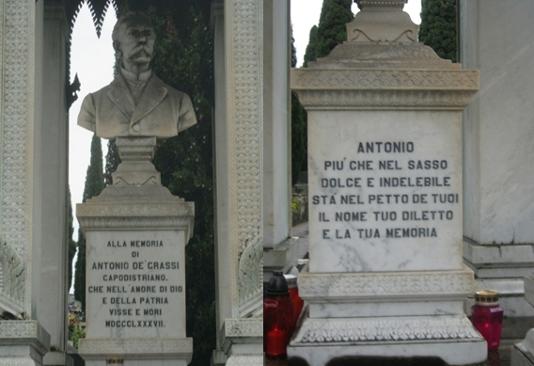
South West
To the memory of Antonio de’ Grassi Antonio
from Capodistria, who in the love of God more than in the stone
and of the Fatherland lived and died sweet and indelible
MDCCCLXXXVII remains in the chest of your family
your beloved name and your memory
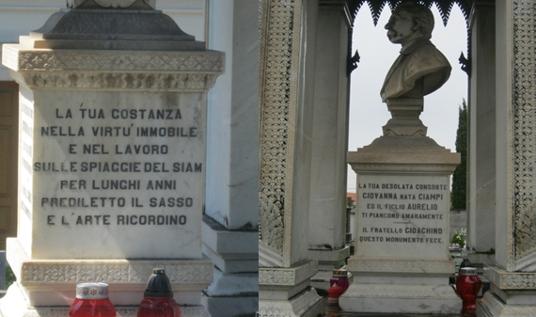
North East
Your perseverance Your desolate consort
in the immovable virtue Giovanna born
and in the work Ciampi
on the beaches of and the son Aurelio
Siam ---------------------------------------
for long years to come The brother Gioachino
the dearest stone this monument made
and the art remember
On this base there stands the herma of Antonio, a moustached gentleman with an imposing appearance.
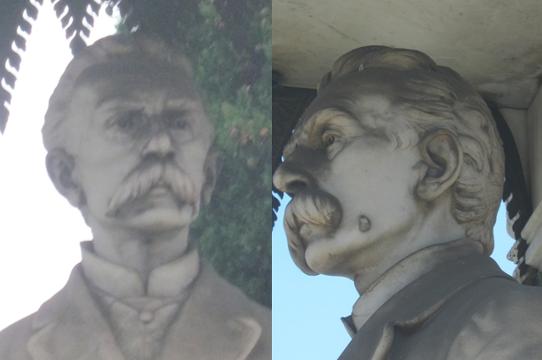
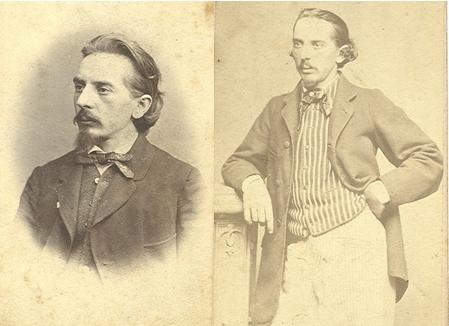
The triple pillars supporting the upper and more characteristic part of the monument are decorated with a scale-motive following the snakeskin.
The Naga is a special snake, for he is a semi-divine snake dwelling underground and watch rich treasures. He is also a symbol of the Ocean. He is to be found in lakes and in the sky, where can cause the rain. In the stormy days appears as a rainbow, a link between the earth and the sky. As such, a couple of Nagas supported the stairs used by Buddha to descend from the heaven. The Naga-King, Muchalinda, opened his seven heads for seven days in order to protect the meditating Buddha. The Nagas are enemies of Garuda. The motive of the Nagas fighting Garuda is common in Thai art. Moreover, the snakes symbolised the wisdom and the healing. We shall speak again on the Nagas when describing the frontons of the tomb.
On the architraves connecting the four triple pillars one finds the four frontons, two of which deserve a closer look [on subsequent pages]. The slanting sides of the fronton have a triple cornice moulded in the shape of a Naga (Nak sadung). In Thailand their body is decorated with glazed pottery tiles, while here the scales (Bai raka) are made of marble.
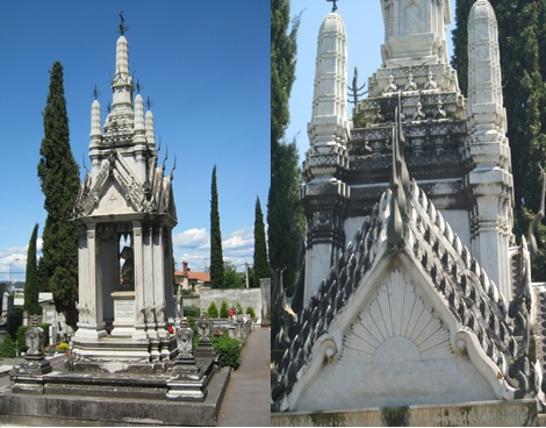
At the upper and lower end of the slanting sides representing the Nak sadung, we find three elegant stylised elements normally present on the roofs of the sacred buildings: the chofas.
The thin apex looking as a stylised bird adorning the two ends of the roof are variously translated as “bunch of sky” or “tassel of sky”. It represents the Garuda , Vishnu’s vehicle adopted by Buddhism to attract Vishnu believers. His representation by means of a stylised bird head is consistent with the Bangkok or Rattanakosin style. At the finishing of a temple it is used to have a ceremony ending with the placing of the chofas.
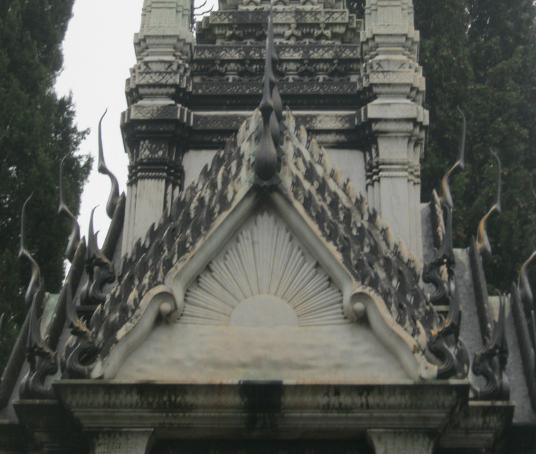
Southern fronton (south side)
A gate of the Wat Phra Keo [Temple of Emerald Buddha in Bangkok] is surmounted by a prang [a tall tower-like richly carved spire ]. Two yakshas, two giants, with a cruel face and the sharpened canines stand on the sides of the gate [as protectors].
[The yakshas at Wat Arun]
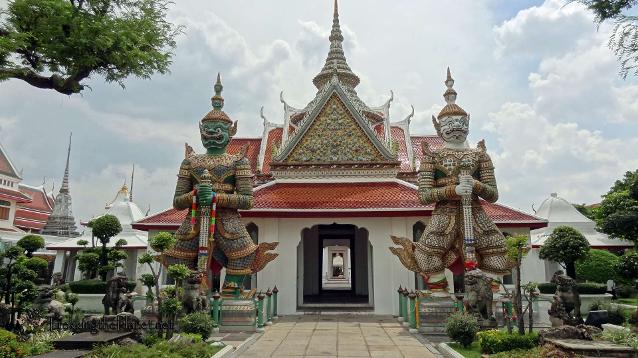
[Images of Wat Phra Keo and Wat Arun]
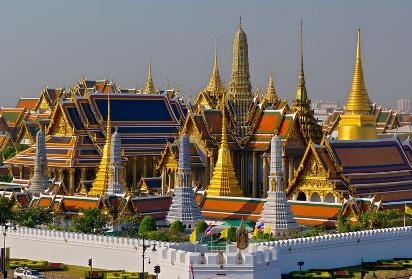
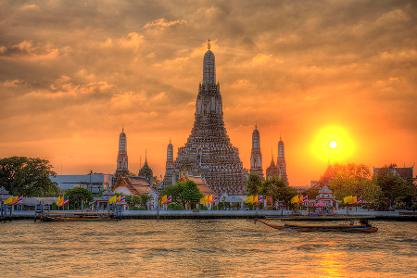
Eastern fronton (east side)
Here we have a Buddha in Bhumisparsamudra, that is Buddha calling the earth to witness.
Inside the space delimited by the frontons there is another pedestal on which stand the five prangs.
The four smaller prangs are placed on the corners while the larger, central one on a stepped base.
[T]he tower represents, according to the Buddhist cosmogony, the Mount Meru, that is the abode of the gods, while the other four smaller prangs represent the mountains on the four cardinal points where resides the sun, the moon and the stars.
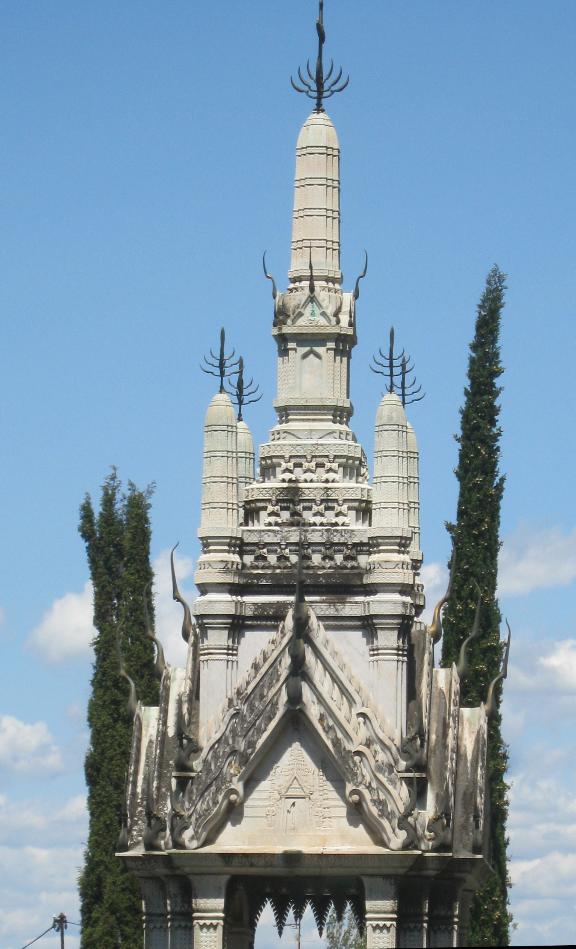
In Thailand the [prang] was built with … elegant shapes and … features, such as a trident on the summit, and some niches on the upper part of the tower representing the dwelling of the god Indra.... [Each] niche is, on its turn, surmounted by small triangular gables decorated, as the lower gables, with the “chofa”.

[Below the niche are] three steps on which one can see five, four and three aligned angels’ (Theppanom) statues respectively. They wear coneshaped headgears.
The uppermost part of the monument is certainly unorthodox from a Buddhist viewpoint, but consistent with the cemeterial setting, as it is topped by a Christian cross.
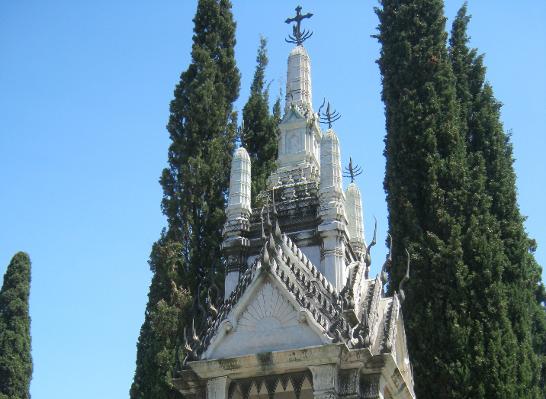
<<<<<< >>>>>>
It is with the utmost gratitude that I dedicate this presentation to Lucio Nalesini, historian and teacher extraordinaire. Thank you for sharing this blessing of the Grassi / deGrassi / de Grassi family.
It is with the utmost gratitude that I dedicate this presentation to Lucio Nalesini, a new found friend, historian and teacher extraordinaire. Thank you for sharing this blessing of the Grassi / deGrassi / de Grassi family.